Imagine standing beneath a towering cedar, its roots twisting like ancient veins, as the roar of a distant waterfall echoes through the forest. This is Vancouver Island, a perfect place for a photographer, where every corner offers a new story waiting to be captured. And this guide will help you make the most of your Vancouver Island photography adventure.
From ancient forests to roaring waterfalls and abundant wildlife, this island offers endless opportunities to capture nature’s raw beauty. So grab your camera and let’s explore some of the best Vancouver Island has to offer!
By Guest Contributor Seth Macey
What You’ll Learn in This Post:
- How to prepare for photographing Vancouver Island’s diverse landscapes, from towering old-growth forests to cascading waterfalls
- Tips for capturing the texture and scale of waterfalls using both long exposure and fast shutter speeds
- Wildlife photography techniques for herons, deer, and more while respecting their natural behavior
- Best lenses and accessories for forests, waterfalls, and wildlife photography
- Must-see landmarks and hidden gems to explore
Discover the Magic of Vancouver Island Photography
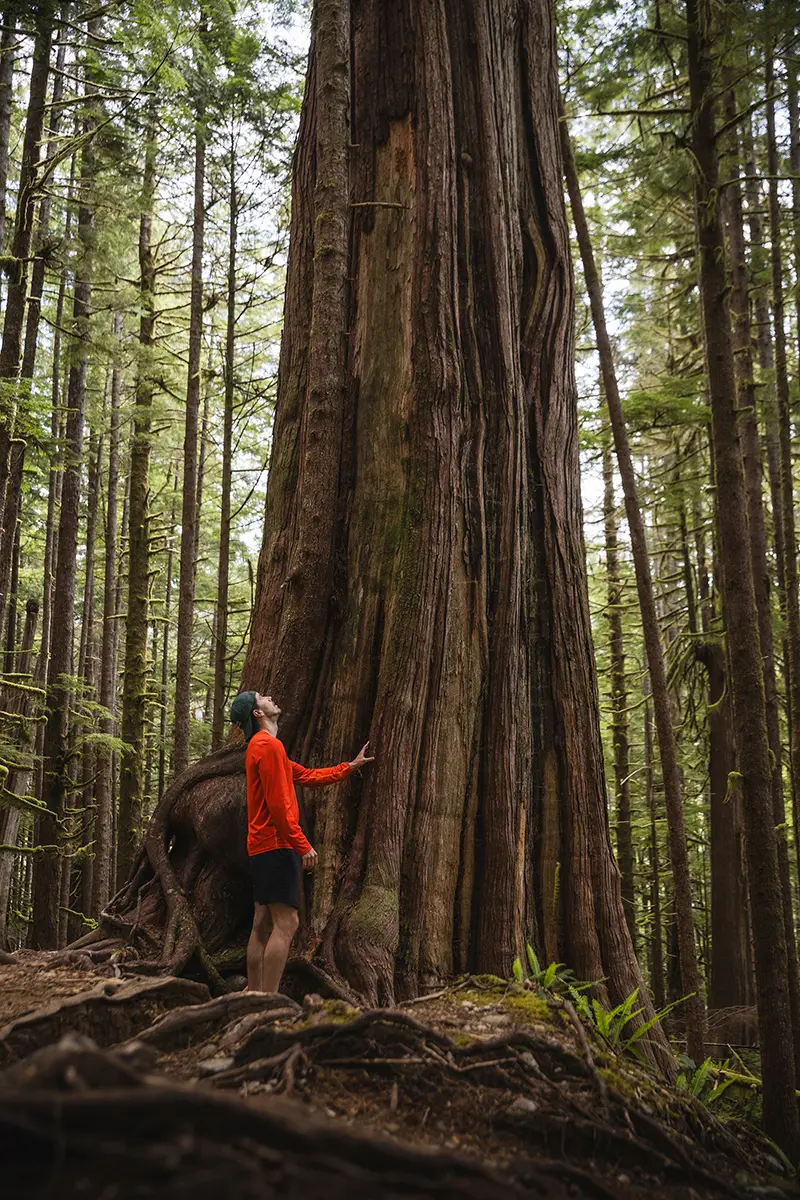
Vancouver Island photography is more than just capturing incredible scenery, it’s about fully immersing yourself in a place where nature reigns supreme. For someone like me, coming from Ontario, the sheer size of the ancient trees in the old growth forests was unbelievable.
This trip during the summer was one I’d been dreaming about. The long daylight hours made it the perfect season to explore all Vancouver Island had to offer. From photographing Myra Falls in Strathcona Provincial Park to admiring ancient giant douglas fir and cedar trees, every moment was unforgettable.
How to Prepare for Your Vancouver Island Photography Adventure
Before you head out to explore some of the best photography spots Vancouver Island has to offer, preparation is key. The island’s unpredictable weather, rugged terrain, and wildlife require a thoughtful packing list.
Packing Essentials
- Rain Gear & Layers: Vancouver Island’s wet climate ensures you’ll need waterproof layers. My rain jacket saved me from countless downpours, especially near waterfalls.
- Waterproof Bags: These are a must to protect camera gear, particularly when doing waterfall photography on Vancouver Island.
- Bear Spray: Black bears are frequent on the island. Staying alert and carrying bear spray ensures your safety.
Staying Flexible – Forest Fires and Weather Can Alter Your Itinerary
Although unlikely, forest fires could impact your plans, as they did for me. A fire on the only main highway across the island near MacMillan Grove forced me to pivot my entire itinerary, cancel a Tofino visit entirely, and skip some planned landmarks.
While missing Tofino and MacMillan Grove was disappointing, the detour led me to Avatar Grove, a place I might have otherwise overlooked. It was a reminder that sometimes great experiences come from unexpected changes in plans.
The Best Lenses for Vancouver Island Photography
Vancouver Island’s diverse photography locations call for versatile lenses. Here’s a perfect set-up for photographing everything the area has to offer:
- Tamron 28-75mm F/2.8 Di III VXD (Model A063): A dream for landscapes, offering gorgeous detail of waterfalls and forests, even in low light.
- Tamron 150-500mm F/5-6.7 Di III VC VXD (Model A057): Essential for wildlife like herons or deer, allowing you to zoom in comfortably from a respectful distance.
- Tamron 28-300mm F/4-7.1 Di III VXD (Model A074): An excellent all-in-one option, great for both landscapes and wildlife without the hassle of frequent lens changes.
- Tamron 16-30mm F/2.8 Di III VXD (Model A064): If you want a little wider perspective for wide shots with foreground composition.
Vancouver Island Waterfall Photography
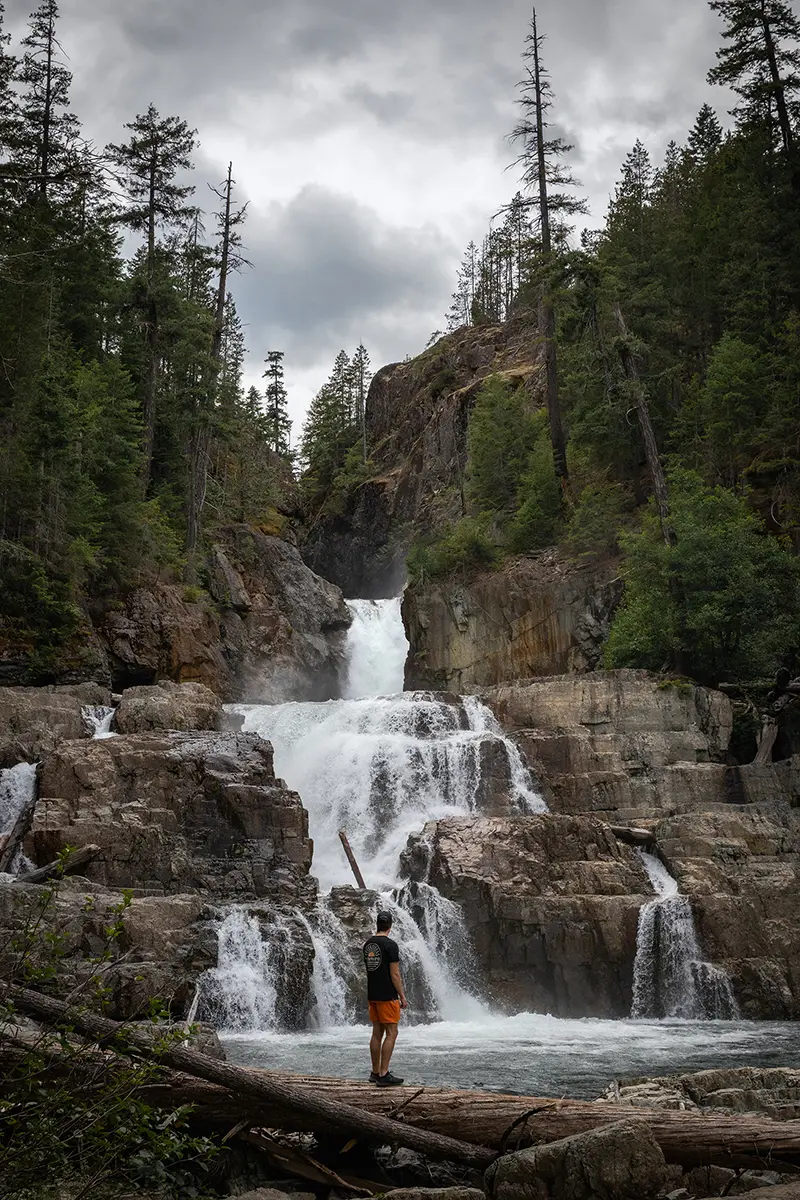
Vancouver Island is home to some of the most stunning waterfalls in Canada, including Myra Falls in Strathcona Provincial Park. Standing beside its roaring waters was truly energizing. I highly recommend adding this location to your itinerary as it’s one of the best Vancouver Island photo spots in my opinion.
The sheer power and sound of the rushing water made me feel small in the best possible way. I even braved a cold dip in one of its calmer pools, a refreshing experience!
Pro Tip: Use a Neutral Density Filter and Tripod for that Silky-Smooth Effect
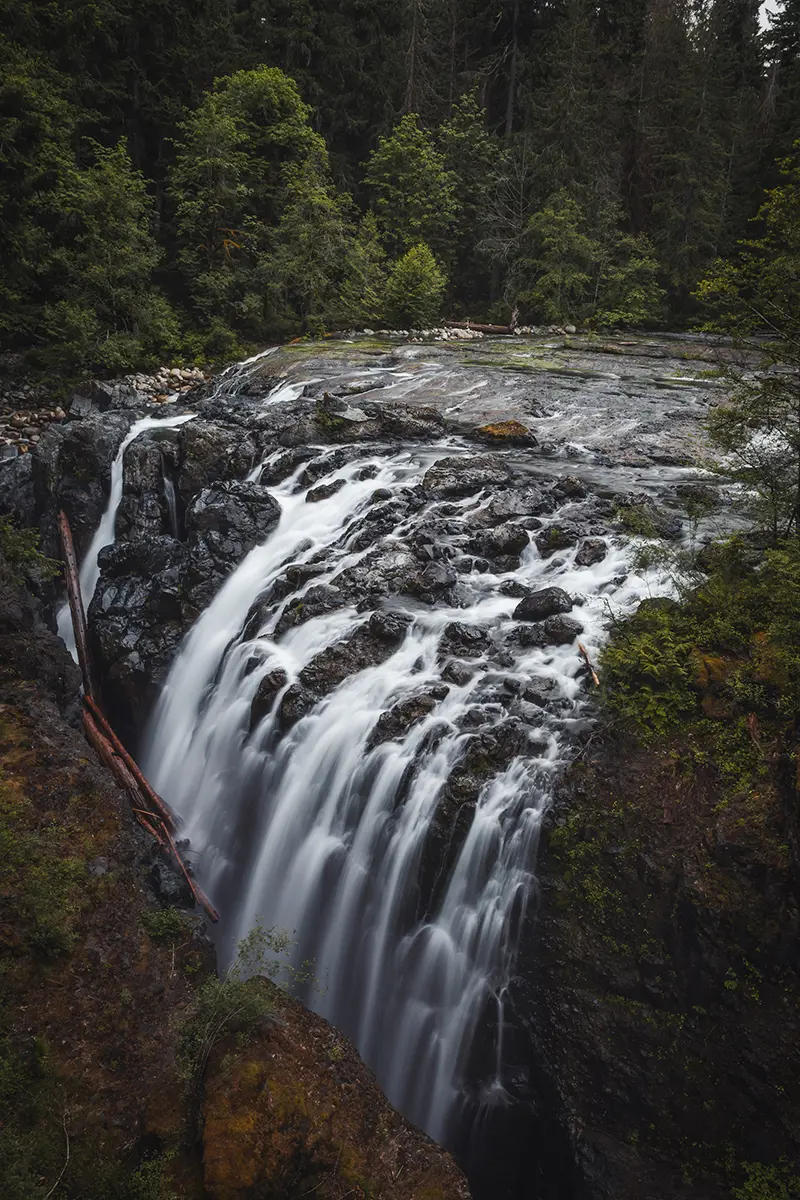
When it comes to waterfall photography, I know most people reach straight for the long exposure to get that classic, silky-smooth effect. It’s a technique audiences love, and for good reason, since there’s something undeniably magical about a waterfall turned to soft ribbons with a slow shutter and ND filter (neutral density filter). I always make sure to get a few of these shots, because they really do have that crowd-pleasing quality.
But personally, I gravitate toward fast shutter speeds when photographing waterfalls. There’s something about freezing every droplet, capturing the crisp texture and energy of the falling water, that feels more true to how I experienced it on the spot.
On Vancouver Island, I made a point to photograph each waterfall with both approaches, long exposures to appeal to the classic aesthetic, and quick bursts to satisfy my own artistic style and highlight the raw movement.
Pro Tip: Frame Your Waterfall Images with Intention

No matter what your shutter choice, I believe how you frame your waterfall matters just as much. I love to zoom out or shoot from a distance, using rocks, mossy trees, or fallen logs to add scale and context. Including these surrounding elements doesn’t just anchor the scene, it gives your images a sense of place and personality, making every shot uniquely yours.
Vancouver Island Wildlife Photography
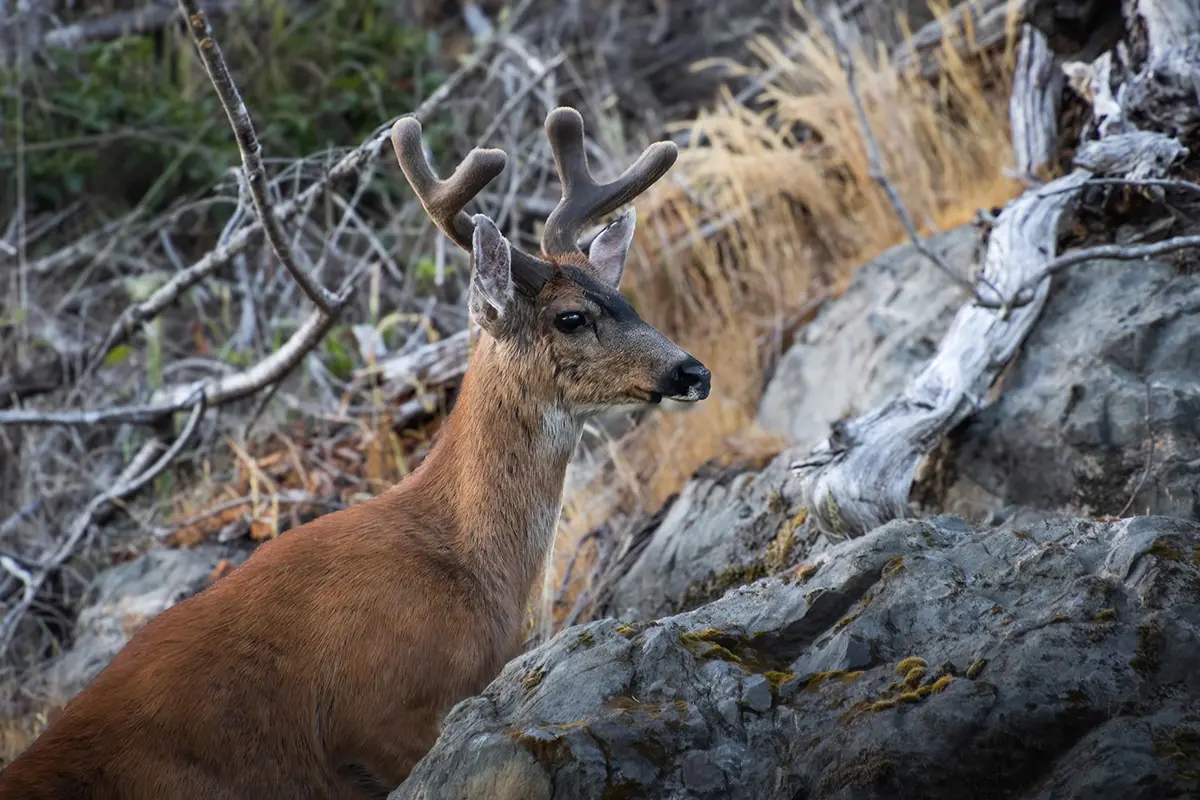
Nothing compares to the thrill of photographing wildlife. While Vancouver Island’s dense forests boast the world’s highest concentration of mountain lions, I didn’t see any during my visit (though I had hoped to!). Fortunately, opportunities to photograph deer and great blue herons presented themselves during my trip.
One encounter with two deer stands out as especially memorable. As I stood quietly, two deer suddenly appeared over the ridge, silent and graceful. It was a moment I hadn’t planned for, but I quickly adjusted my camera settings using the memory recall feature to quickly switch to my wildlife preset.
Thankfully, I was using a Tamron all-in-one zoom lens that let me easily switch from shooting landscapes to capturing the deer without needing to change lenses.
Having presets or memory recalls for different scenarios, like wildlife, landscapes, and video, ensures I’m always ready for those fleeting moments. On Vancouver Island, where the light and scenery can change in an instant, this feature was invaluable.
I also use dual card slots to keep my photos and videos separate, making post-processing much easier. These small adjustments help me stay efficient and focused on capturing the moment.
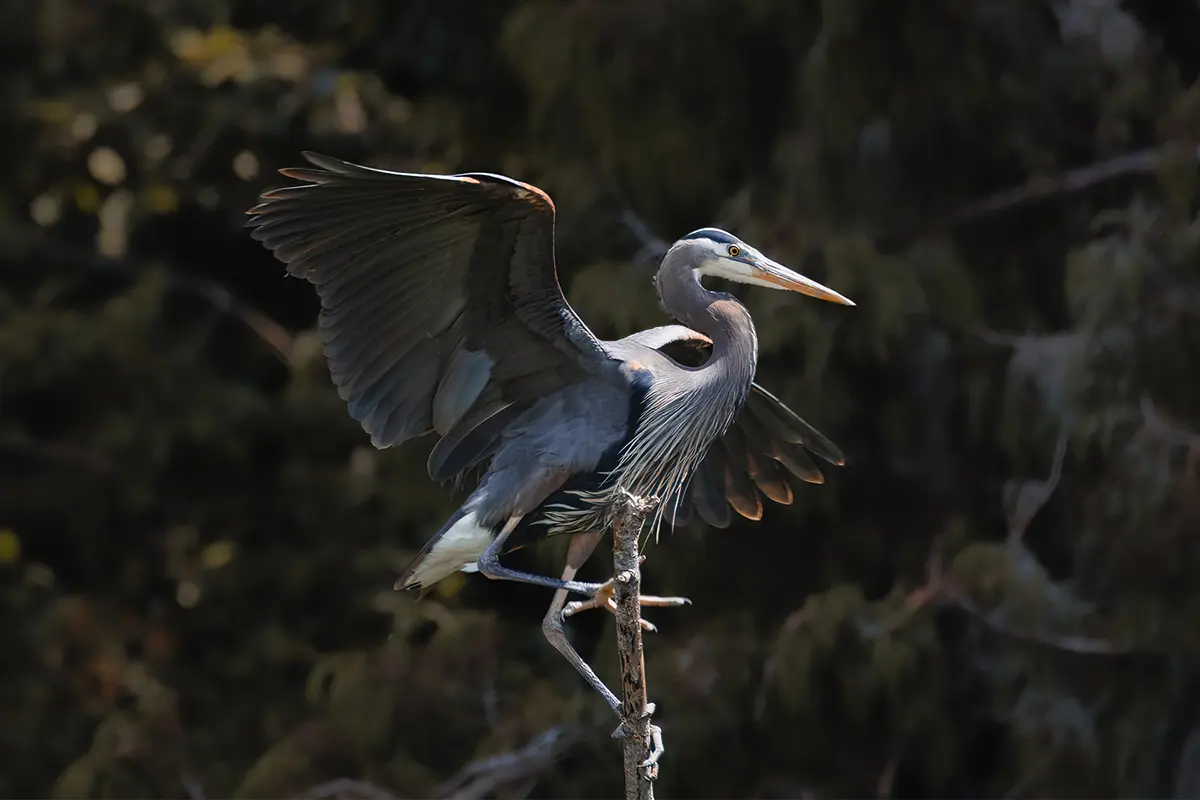
Another unforgettable experience was witnessing hundreds of great blue herons flying from their nests to the tidal flats to gather food. The noise was deafening, and the chaos of eagles attempting to hunt their young made it hard to know where to point my camera.
Herons clung desperately to branches mid-flight as eagles swooped in, attempting coordinated attacks. Moments like that remind you why continuous focus mode and a telephoto lens are your best friends in wildlife photography.
Key Tips for Wildlife Photography
Use Continuous Focus Mode
Animal movement is unpredictable, so I always use continuous focus mode to make sure my subject stays sharp as it moves. Photographing wildlife, I also like to use a long lens with at least 400mm capability. This helps me keep a respectful distance while still capturing close-up, detailed shots.
Be Deliberate
It can be easy to just click away at wildlife photos, but I try to be intentional and capture something that feels visually interesting to me. For example, in the instance of the deer, it was coming up over a rock ledge, and in the heron photograph, it was balancing like a gymnast on a branch. Waiting for these unique behaviors or moments that show something interesting can make your wildlife photography stand out and feel more personal.
Respect Nature
Stressing wildlife isn’t worth it. My rule of thumb is that if the animal isn’t changing its behavior, like eating, tending to its young, or moving naturally, you’re probably being quiet enough and are far enough away.
Obviously, this doesn’t mean you should ever get close to something like a grizzly bear, but as a general guideline, it helps me make sure I’m not causing unnecessary stress. Stressing out animals is no fun for me and shouldn’t be part of the experience.
Vancouver Island Old Growth Forest Photography

The soul of Vancouver Island landscape photography lies in its ancient forests. Avatar Grove, steeped in moss and mystery, is one of the best Vancouver Island photography spots for old-growth forest enthusiasts. These trees feel like characters, a rich mix of grandeur and uniqueness.
Centuries Old Cedars

For me, trees are more than just a subject. They are alive, and I like to assign them personalities. Cedars, in particular, are my favorite, with their marvelous scent and timeless presence. I love walking through forests and picking out my favorite trees.
Canada’s Gnarliest Tree
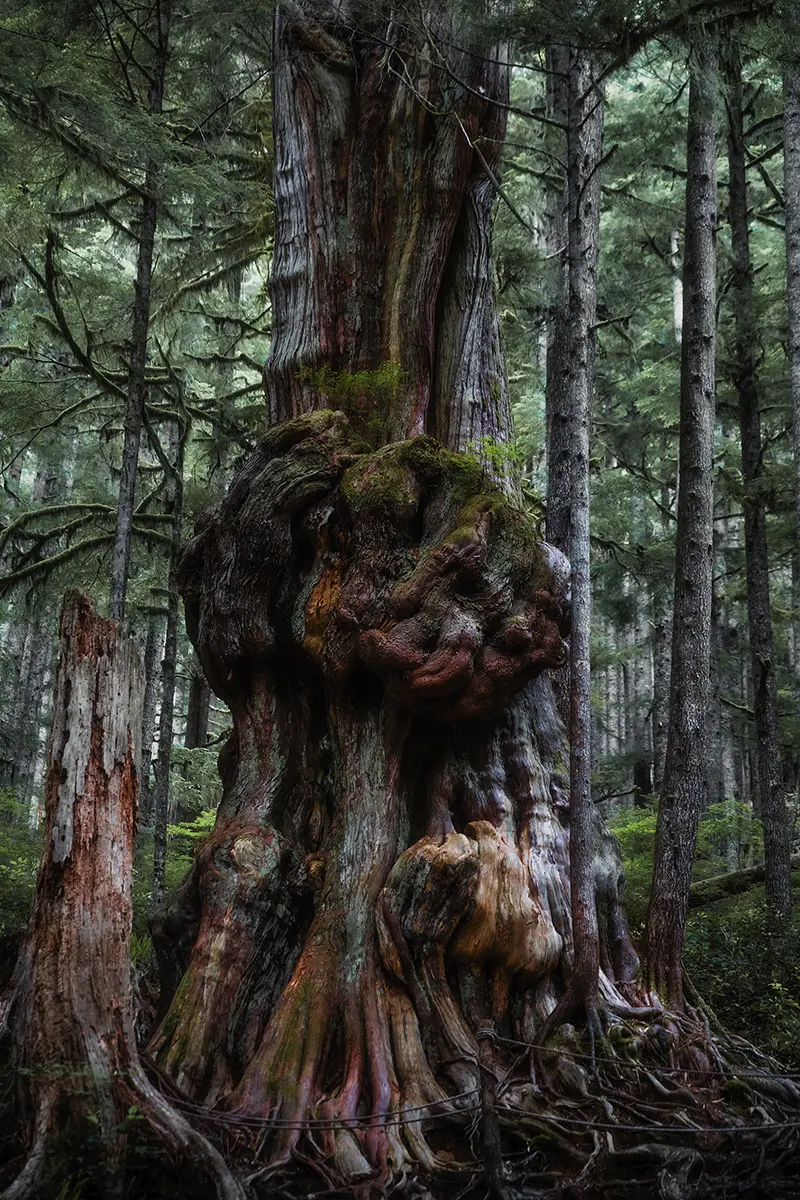
One tree, known as “Canada’s Gnarliest Tree”, left me speechless. Its knotted, bulging surface surely carried stories centuries older than me. This tree felt to me like the sage of the forest with thickly veined roots and bulbous burls. Visit this grove if you feel like standing in the presence of living history.
Forest and Tree Photography Tips
- Show Scale: Including a human subject in your shot not only provides a sense of scale but also highlights what makes these trees so captivating. Sometimes the sheer size is what’s most striking. Imagine placing a person in the frame and realizing it would take four people just to wrap their arms around the trunk. By placing a human subject in frame against a massive tree, you can emphasize its incredible diameter and help viewers truly grasp its impressive dimensions.
- Focus on Details: Moss cascading over branches and roots erupting from a tree’s base like thick, tangled veins can create striking natural compositions. Sometimes, it’s a gnarled, grotesque burl protruding from the trunk that catches the eye. Seek out these unique features to capture the essence and story of each ancient tree.
- Be Mindful of Distortion: While wide-angle lenses help capture a vast scene, they can distort a tree’s proportions by bending the trunk in unrealistic ways or making it look much skinnier than it really is, especially when you’re shooting from the ground up. This can take away from the true sense of size you’re trying to convey, unless you’re intentionally aiming for that artistic effect.
- Mastering Low-Light Photography in Forests: Forests often have diffused light, which can work in your favor, but having a lens with a wide aperture like f/2.8 is invaluable for letting in more light. And with modern denoise software like Topaz or Lightroom, shooting at higher ISOs like 10,000 on a mirrorless camera isn’t as daunting as it used to be.
Final Thoughts on a Vancouver Island Photography Adventure
Vancouver Island is a wonderland of ancient trees, roaring waterfalls, and vibrant wildlife, offering endless opportunities for photographers to capture nature’s raw beauty.
As you explore and capture these incredible landscapes, remember that each photo is not just a memory, but a reminder of what’s worth preserving. Let’s all do our part to protect these wild places for future generations.
Until next time, keep your camera ready and your curiosity alive!
Learn more about the Tamron lenses Seth Macey recommends for Vancouver Island photography at an authorized Tamron dealer near you or visit the TAMRON Store.
About Seth Macey
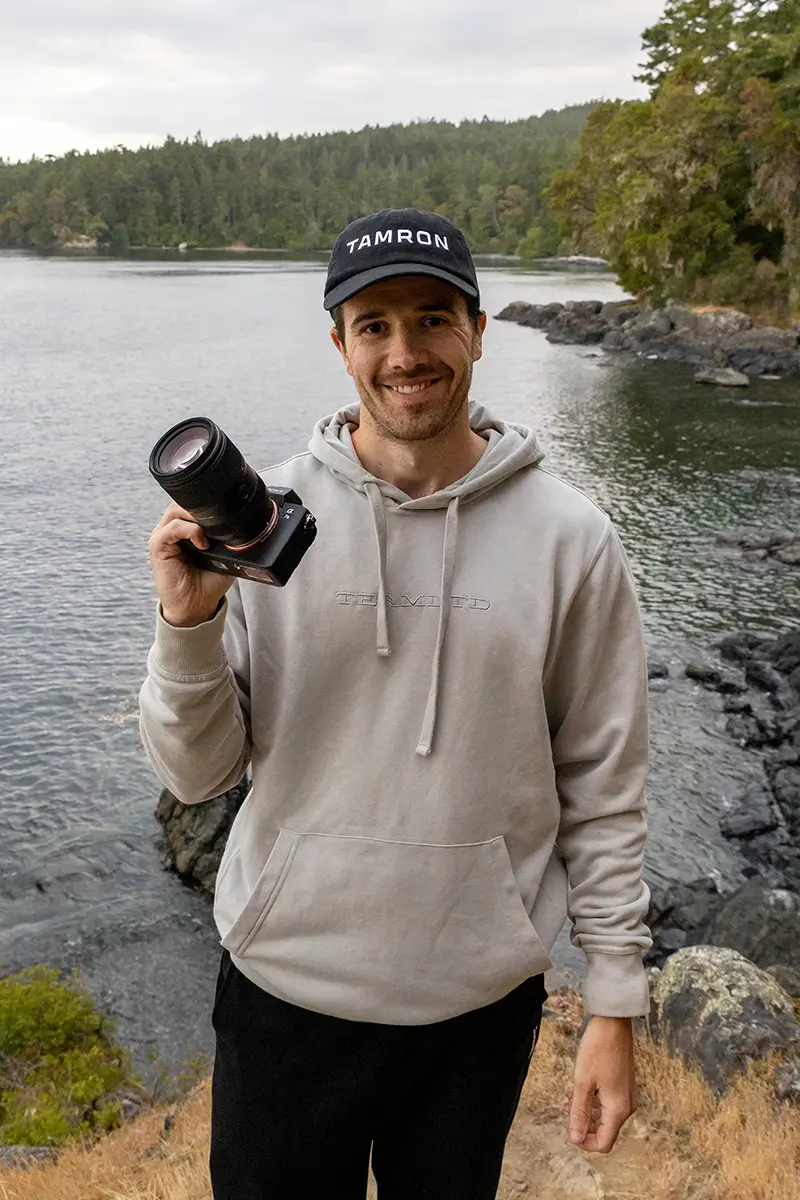
Seth Macey is a wildlife and landscape photographer based in Ontario, Canada. Seth spends most of his time behind the lens immersed in nature, learning the land, researching, and tracking animal subjects. He is also the co-host of the Photographer Mindset Podcast, sharing ways in which listeners can build their mental fortitude, develop out-of-the-box thinking strategies, and work efficiently towards their own versions of success in photography. Website | Instagram
